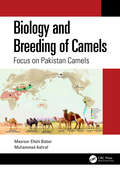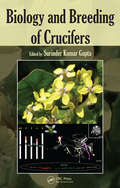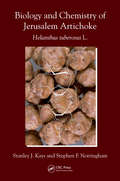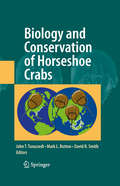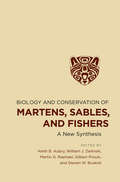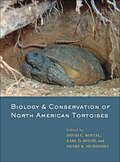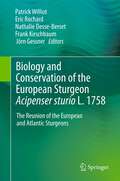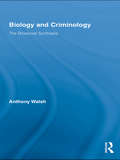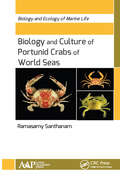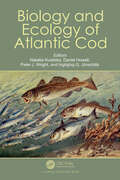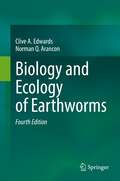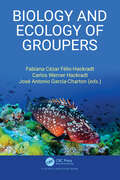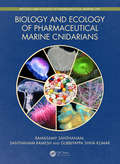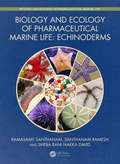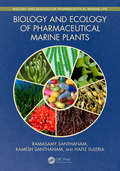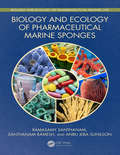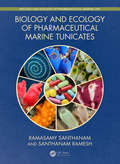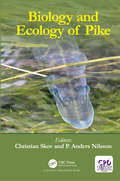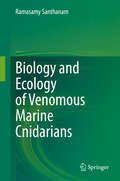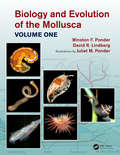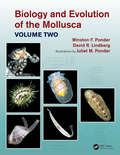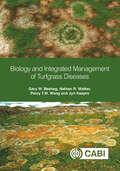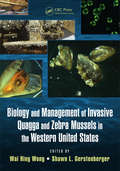- Table View
- List View
Biology and Breeding of Camels: Focus on Pakistan Camels
by Muhammad Ashraf Masroor Ellahi BabarThis book discusses the biology, breeding, care, and management of camels, with a focus on camels from Pakistan. The book provides a sound understanding of how to look after camels, their senses, behavior, and adaptations. The chapters describe the practical aspects of camel husbandry such as how to maintain their body condition, feet, and cleanliness. It covers the types of feeds, feeding methods, and their needs at different stages of life. The book provides a detailed account of camel husbandry, breeding, and reproduction. It is meant for camel breeders, veterinarians, livestock advisers, students, and researchers working on animal sciences, camel rearing, feeding, and management. FEATURES Includes information about different species of camels present in Pakistan and their importance to humans Discusses the nutrition and feeding of camels, the medicinal qualities of camel milk, and the peculiar immunity-enhancing properties of their nutritious meat Describes the features of camels that help them survive and thrive in deserts and make them the animals of the future Covers the range of unique products obtained from camels and their economic value Explores the management, types of diseases in camels, causes of their spread, their control, and therapeutic measures for successful and productive farming
Biology and Breeding of Crucifers
by Surinder Kumar GuptaConsiderable interest has developed in recent years in crucifers and particularly in their wild relatives, as they contain genetic material that may be utilized for further evolution of superior crop varieties through introgression and distant hybridization. Until now, there has been no single volume that focuses exclusively on the biology and bree
Biology and Chemistry of Jerusalem Artichoke: Helianthus tuberosus L.
by Stanley J. Kays Stephen F. NottinghamA unique plant on many levels, the distinctive properties of the Jerusalem artichoke, or Helianthus tuberosus L., present novel answers to some of today's most pressing problems. The potential of Jerusalem artichoke as a source for inulin, a fructose polymer that may provide dietary health benefits for obesity, diabetes, and several other health is
Biology and Conservation of Horseshoe Crabs
by David Smith Mark L. Botton John T. TanacrediThe four living species of horseshoe crabs face a set of growing threats to their survival, including the erosion and/or man-made alteration of essential spawning habitat, coastal pollution, and overfishing. Horseshoe crabs are "living fossils", with a more than 200 million year evolutionary history. Their blood provides a reagent, known as Limulus amebocyte lysate or LAL, that clots in the presence of minute quantities of bacterial endotoxin; the LAL test is the state-of-the-art methodology used to ensure that pharmaceuticals and surgical implants are free of contamination. Horseshoe crabs are an integral part of the food web in coastal marine ecosystems, and their eggs provide essential food for shorebirds in the Delaware Bay estuary each spring. The commercial fishery for horseshoe crabs, which utilizes animals for bait, contributes to the economies of coastal communities. This book consists of papers presented at the 2007 International Symposium on the Science and Conservation of Horseshoe Crabs.
Biology and Conservation of Martens, Sables, and Fishers: A New Synthesis
by Steven W. Buskirk Martin G. Raphael Keith B. Aubry William J. Zielinski Gilbert ProulxMammals in the genus Martes are mid-sized carnivores of great importance to forest ecosystems. This book, the successor to Martens, Sables, and Fishers: Biology and Conservation, provides a scientific basis for management and conservation efforts designed to maintain or enhance the populations and habitats of Martes species throughout the world. The twenty synthesis chapters contained in this book bring together the perspectives and expertise of 63 scientists from twelve countries, and are organized by the five key themes of evolution and biogeography, population biology and management, habitat ecology and management, research techniques, and conservation.Recent developments in research technologies such as modeling and genetics, biological knowledge about pathogens and parasites, and concerns about the potential effects of global warming on the distribution and status of Martes populations make new syntheses of these areas especially timely. The volume provides an overview of what is known while clarifying initiatives for future research and conservation priorities, and will be of interest to mammalogists, resource managers, applied ecologists, and conservation biologists.
Biology and Conservation of North American Tortoises
by David C. Rostal, Earl D. McCoy, and Henry R. MushinskyThe most comprehensive book ever published on North America's native tortoises.Tortoises, those unmistakable turtles, evolved from a lineage that split off from the familiar pond turtles roughly 100 million years ago. Over time, these plant-eating land turtles spread around the world, growing to an enormous size (depending on the species) and living so long that they have become the stuff of legends. By most accounts, they are indeed the longest-lived of the turtles, with good records suggesting individuals may live as long as 180 years (anecdotal records suggest that some reach ages of 200 years or more).Providing the first comprehensive treatment of North America’s tortoises, Biology and Conservation of North American Tortoises brings together leading experts to give an overview of tortoise morphology, taxonomy, systematics, paleontology, physiology, ecology, behavior, reproduction, diet, growth, health, and conservation. The contributors carefully combine their own expertise and observations with results from studies conducted by hundreds of other researchers. The result is a book that belongs in the library of every herpetologist.ContributorsGustavo Aguirre L.Linda J. AllisonMatthew J. ArescoRoy C. Averill-MurrayJoan E. BerishKristin H. BerryDennis M. BrambleK. Kristina DrakeTaylor EdwardsTodd C. EsqueRichard FranzCraig GuyerJ. Scott HarrisonSharon M. HermannJ. Howard HutchisonElliott R. JacobsonValerie M. JohnsonRichard T. KazmaierEarl D. McCoyPhilip A. MedicaRobert W. MurphyHenry R. Mushinsky Kenneth E. NussearMichael P. O’ConnorThomas A. Radzio David C. RostalLora L. SmithJames R. SpotilaCraig B. StanfordC. Richard TracyTracey D. TubervilleMichael TumaThane Wibbels
Biology and Conservation of the European Sturgeon Acipenser sturio L. 1758: The Reunion of the European and Atlantic Sturgeons
by Eric Rochard Frank Kirschbaum Jörn Gessner Nathalie Desse-Berset Patrick WilliotThe book aims at synthesizing our current knowledge of Acipenser sturio and its management. This species, one of the most widespread sturgeon species all over Western Europe ranging from the Black Sea to the Baltic, is now on the verge of extinction. Major aspects of its biology and management, including mismanagement, are provided in a historic perspective. Similarly, the changes in the restoration programs (in situ and ex situ) initiated in France and Germany are presented. As the species occurred in sympatry with Acipenser oxyrinchus in Germany and Poland and very recently in France as well, a brief outlook on restoration-management programs of A. oxyrinchus are also provided for both North America and Northern European countries, namely Germany and Poland. As conservation-restoration actions go beyond scientific issues, non-governmental stakeholders and marine professional fishermen's organizations have also been asked to contribute, and the key role of a French-German cooperation plan is underlined. A part of the book is devoted to perspectives. Illustrations of the European sturgeon, mainly in photographs, but also in stamps and paintings, are presented.
Biology and Criminology: The Biosocial Synthesis (Routledge Advances in Criminology)
by Anthony WalshNumerous criminologists have noted their dissatisfaction with the state of criminology. The need for a new paradigm for the 21st century is clear. However, many distrust biology as a factor in studies of criminal behavior, whether because of limited exposure or because the orientation of criminology in general has a propensity to see it as racist, classist, or at least illiberal. This innovative new book by noted criminologist Anthony Walsh dispels such fears, examining how information from the biological sciences strengthens criminology work and both complements and improves upon traditional theories of criminal behavior. With its reasoned case for biological science as a fundamental tool of the criminologist, Walsh's groundbreaking work will be required reading for all students and faculty within the field of criminology.
Biology and Culture of Portunid Crabs of World Seas (Biology and Ecology of Marine Life)
by Ramasamy SanthanamBiology and Culture of Portunid Crabs of World Seas provides an abundance of valuable first-hand information about the diversity, biology, ecology culture of the portunid crabs of the word seas. Marine crabs play an important role directly or indirectly in the livelihood of millions of people around the world. They have been reported to make up about 20% of all marine crustaceans caught, farmed, and consumed worldwide. Among these marine crabs, portunid crabs or swimming crabs of the family Portunidae (Class: Crustacea; Order: Decapoda; Infraorder: Brachyura) assume greater significance in the marine industry owing to their delicate meat with nutritional qualities. Although, several species of portunid crabs are edible and commercially important, only a few species of Scylla and Portunus have been widely cultivated. This is largely due to the lack of information on the biology of portunid crabs. Keeping this in view, this new volume presents the biology and aquaculture of marine portunid crabs. This volume will be of great use for researchers and students of disciplines such as fisheries science, marine biology, aquatic biology and fisheries and zoology and will also serve as a standard reference for college, university, and research libraries around the world.
Biology and Ecology of Atlantic Cod
by Peter J. Wright Daniel Howell Nataliia Kulatska Ingibjörg G. JónsdóttirAtlantic cod is an important fish species in human history and continues to be a major influence on North Atlantic fisheries management, as stock collapses and recoveries impact coastal communities and shelf sea food webs. This book provides an overview of Atlantic cod biology and ecology, focussing on regional differences in life-history and stock dynamics that affect productivity and the challenges faced by management. By comparing the success of management approaches and the local influence of changing climate and food webs, the book highlights the different pressures facing stocks and identifies knowledge gaps across the species’ range.
Biology and Ecology of Earthworms
by Clive A. Edwards Norman Q. AranconBiology and Ecology of Earthworms is established as a key valuable text for students of agriculture, soil science, and soil invertebrate zoology and ecology. This is the 4th Edition of the popular textbook which reviews all aspects of earthworm biology and ecology. The book has been fully revised and updated throughout. Particular changes include: new treatments of earthworm taxonomy, diversity, migration and geographical distribution; interactions between earthworms and other soil organisms, especially microorganisms and soil-borne pests and diseases; as well as the importance of earthworms in organic waste management.
Biology and Ecology of Groupers
by Fabiana Cézar Félix-HackradtGroupers are fascinating charismatic fishes commonly found in reef habitats around the world that sustain a global multimillionaire fishery. They are an important top predator species and therefore of paramount ecological importance for reef systems' resilience. The book, Biology and Ecology of Groupers is an up-to-date review of the main bio-ecological topics involving worldwide groupers species oriented to the academic community and managers. It covers aspects of classification and phylogenetic relationships, geographical distribution, and life history related characteristics (Section I), including the major threats of groupers populations, case studies of successful management and comments about the future of groupers in our changing world (Section II).
Biology and Ecology of Pharmaceutical Marine Cnidarians (Biology and Ecology of Marine Life)
by Ramasamy Santhanam Santhanam Ramesh Gubbiyappa Shiva KumarThe first comprehensive book on the biology and ecology of pharmaceutical cnidarians, answering a need for more knowledge about the identification, biology, natural products and bioactivities of these living resources. Contributed by scientists of both marine biology and pharmacy disciplines. Identifies the correct marine species, shows the ecological parameters of that species, and explores its biological values with particular attention to primary and secondary metabolites or bioactive constituents. A useful supplementary text on Marine Biology and Pharmacology courses. Nearly 200 illustrations are produced in full color, providing a high-quality reference. This book provides the taxonomy, common name, global distribution, habitat, diagnostic features, and pharmaceutical compounds (along with their activities) of 200 species of marine cnidarians along with nearly 200 detailed illustrations in glorious color. The phylum Cnidaria (formerly Coelenterata) is a large, diverse, and ecologically important group of marine invertebrates which make up 40 percent of the biomass of the oceans. Marine invertebrates are the richest source of marine natural products with potential applications in the pharmaceutical and medical sectors, and it has been reported that over 3000 bioactive compounds have been described from this phylum alone, mostly in the last decade.
Biology and Ecology of Pharmaceutical Marine Life: Echinoderms (Biology and Ecology of Marine Life)
by Ramasamy Santhanam Santhanam Ramesh Sheba Rani Nakka DavidThe first comprehensive book on the biology and ecology of pharmaceutical echinoderms. Contributed by scientists of both marine biology and pharmacy disciplines. All reported echinoderm species producing secondary metabolites are dealt with. Previously known only as nutritional invertebrates, the contribution of the echinoderms as sources of secondary metabolites for therapeutic compounds is a topic ripe for exploration. All 200+ images are produced in full color. This book provides the taxonomy, common name, global distribution, habitat, diagnostic features and pharmaceutical compounds (along with their activities) of 150 species of ecinoderms along with over 200 detailed illustrations in glorious color. Among the biota of marine habitats, the echinoderms, which include sea stars (starfish), brittle stars and basket stars, sea urchins and sand dollars, sea cucumbers, and sea lilies or feather stars, are known for their importance as promising sources of bioactive compounds for development of pharmaceuticals. Their potential therapeutic applications have been growing rapidly in the treatment of many diseases.
Biology and Ecology of Pharmaceutical Marine Mollusks (Biology and Ecology of Marine Life)
by Ramasamy Santhanam Santhanam Ramesh Manavalan GobinathKey features: Serves as a standard reference for researchers, teachers and students of various disciplines such as Fisheries Science, Marine Biology, Life Sciences, Biotechnology, Natural Products, Biochemistry, and Pharmacy, their libraries, and as a valuable guide for pharmaceutical companies involved in the development of new drugs Presents the taxonomy, common name, global distribution, and habitat of 275 species of marine molluscs Provides the diagnostic features and pharmaceutical compounds (along with their chemical structure and activities) of 275 species of marine molluscs Includes more than 500 detailed illustrations Covers bivalves, gastropods, and cephalopods Biology and Ecology of Pharmaceutical Marine Molluscs is the first comprehensive book of its kind written by scientists from both the Marine Biology and Pharmacy disciplines to fill the long-felt need for a marine natural products book devoted exclusively to molluscs. The taxonomy, common name, global distribution, habitat, diagnostic features and pharmaceutical compounds (along with their activities) of 275 species of marine molluscs are given in this comprehensive work, with accompanying illustrations. Bioactive substances isolated from marine invertebrates such as poriferans, coelenterates, molluscs, echinoderms, bryozoans and tunicates have been reported to possess antiviral, antimicrobial, antiprotozoal, antifungal, antihelmintic and anticancer activities. Among the marine invertebrates, marine molluscs have significant commercial applications; for instance, as a source of food, ornaments and production of lime. A few species of molluscs have also been reported to act as scavengers in cleaning the environment and pollution indicators. Recently, many molluscan species have been identified as a potential source of secondary metabolites, having a wide range of pharmaceutical applications. This should be a standard reference for students, researchers and teachers of disciplines such as Pharmacy, Fisheries Science, Marine Biology, Life Sciences, Biotechnology and Biochemistry, as well as a valuable guide for pharmaceutical companies involved in the development of new drugs from marine molluscs.
Biology and Ecology of Pharmaceutical Marine Plants (Biology and Ecology of Marine Life)
by Ramasamy Santhanam Santhanam Ramesh Hafiz Ansar SuleriaKey features: A standard reference for researchers, teachers and students of Marine Biology, Fisheries Science, Botany/Plant Science, Biotechnology, Natural Products, and Pharmacy, their libraries A valuable guide for pharmaceutical companies involved in the development of new drugs from marine plants Presents the taxonomy, common name, global distribution, and habitat of 400 species of marine plants Provides the diagnostic features and pharmaceutical compounds (along with their chemical structure and activities) of 400 species of marine plants Includes more than 600 detailed illustrations Covers blue-green algae, green algae, brown algae, and red algae Marine plants such as algae (blue-green algae and seaweeds), seagrasses, mangrove plants, salt-tolerant or salt-loving plants (halophytes) and coastal sand dune plants are known to generate approximately 70% of oxygen on earth, and help regulate oxygen in the atmosphere. These plants are potential sources of nutrients and are also considered valuable for the development of new drugs owing to their unique bioactive compounds. This book provides the taxonomy, common name, global distribution, habitat, diagnostic features and pharmaceutical compounds (along with their activities) of 400 species of marine plants, accompanied by high quality illustrations. Biology and Ecology of Pharmaceutical Marine Plants is the first comprehensive book of its kind written by scientists from both the Marine Biology and Pharmacy disciplines to fill the long-felt need for a marine natural products book devoted exclusively to plants. It should be a standard reference for students, researchers and teachers of disciplines such as Pharmacy, Fisheries Science, Marine Biology, Life Sciences, Biotechnology and Biochemistry, as well as a valuable guide for pharmaceutical companies involved in the development of new drugs from marine plants.
Biology and Ecology of Pharmaceutical Marine Sponges (Biology and Ecology of Marine Life)
by Ramasamy Santhanam Santhanam Ramesh Anbu SunilsonKey features: Serves as a standard reference for researchers, teachers and students of various disciplines such as Fisheries Science, Marine Biology, Life Sciences, Biotechnology, Natural Products, and Pharmacy, their libraries, and as a valuable guide for pharmaceutical companies involved in the development of new drugs from marine sponges Presents the taxonomy, common name, global distribution, and habitat of 250 species of marine sponges Provides the diagnostic features and pharmaceutical compounds (along with their chemical structure and activities) of 450 species of marine sponges Includes more than 500 detailed illustrations Biology and Ecology of Pharmaceutical Marine Sponges is the first comprehensive book of its kind written by scientists from both the Marine Biology and Pharmacy disciplines to fill the long-felt need for a marine natural products book devoted exclusively to sponges. Sponges are the most primitive multicelled animals that have existed for 700 - 800 million years. Despite their wide range of functional roles, not much is known about them. Marine sponges are responsible for more than 5,300 pharmaceutical products and some species have the potential to provide future drugs to prevent and treat important medical conditions such as cancer, a range of viral diseases, malaria, and inflammatory diseases. Nucleosides derived from sponges were the basis for the synthesis of Ara-C, the first marine-derived anticancer agent, currently used in the routine treatment of patients with leukemia and lymphoma. Marine sponges are the potential sources of many unique metabolites with anticancer,anti-inflammatory, antibiotic, antiviral, antimalarial, and immune or neurosuppressive properties. Although many bioactives have been discovered in marine sponges, only a few of these compounds have been commercialized. This book hopes to change that, providing the taxonomy, common name, global distribution, habitat, diagnostic features and pharmaceutical compounds (along with their chemical structure and activities) of 450 species of marine sponges, accompanied by high-quality illustrations. The book should be a standard reference for students, researchers and teachers of disciplines such as Fisheries Science, Marine Biology, Biochemistry, Biotechnology and Pharmacy and a valuable guide for pharmaceutical companies involved in the development of new drugs from marine sponges.
Biology and Ecology of Pharmaceutical Marine Tunicates (Biology and Ecology of Marine Life)
by Ramasamy Santhanam Santhanam RameshThe ocean is a source of unique natural products, mainly accumulated in living organisms. The c.4000 species of tunicates or sea squirts (Phylum, Chordata; Subphylum, Urochordata) are a high-potential yet under-studied source of bioactive compounds for pharmaceuticals. The secondary metabolites such as alkaloids isolated from these organisms have led to the discovery of an approved anti-tumor drug, anti-cancer drugs Yondelis® and Aplidin®, as well as many others in clinical trial. There is an urgent need for more research on the bioactive compounds of marine tunicates and better knowledge about the identification and biology of these species. This is the first focused book to meet this need. The taxonomy, common name, global distribution, habitat, diagnostic features and pharmaceutical compounds (along with their activities) of 165 key species of tunicates are given, with high-quality illustrations. Contributed by scientists of both Marine Biology and Pharmacy disciplines, this book will serve as a standard reference for researchers, teachers and students of Fisheries Science, Marine Biology, Life Sciences, Biotechnology, Natural Products, and Pharmacy, and as a valuable guide for pharmaceutical companies involved in the development of new drugs from marine organisms.
Biology and Ecology of Pike
by Christian Skov P. Anders NilssonThis book sets out to bridge the order scales among pike researchers, populations, communities, management, and fisheries. It emphasizes the progress of pike research during the last two decades, during which the order-bridging approach emerged. This framework underpins the text and the message, to convey its importance to pike research and to fish research in general. In addition, a considerable part of the book is devoted to management implications and highlights aspects of human dimensions in recreational fisheries.
Biology and Ecology of Venomous Marine Cnidarians
by Ramasamy SanthanamSeas and oceans cover 71 % of the earth’s surface and they are home to 80% of all life found on the planet . Among the different components of marine life, the phylum Cnidaria (formerly Coelenterata) has been reported to be responsible for more envenomations than any other marine phylum. It is believed that 2% of its known 11000 species are venomous to humans. Incidents caused by jellyfish are common all around the globe, with serious manifestations and occasional deaths reported in some countries. The Australian box jellyfish, Chironex fleckeri , has been reported to be very dangerous to humans, as contact with its tentacles can provoke immediate cardiovascular collapse and death within minutes. Though other volumes on venomous marine fauna are available, this is the first comprehensive book focusing on venomous marine cnidarians. It is a valuable text-cum-reference resource for researchers, teachers and students of various disciplines, including fisheries science, marine biotechnology and marine biology and for university and college libraries. It is also a useful guide for beachgoers, divers, physicians and environmentalists.
Biology and Evolution of the Mollusca, Volume 1
by Winston Frank Ponder David R. Lindberg Juliet Mary PonderMolluscs comprise the second largest phylum of animals (after arthropods), occurring in virtually all habitats. Some are commercially important, a few are pests and some carry diseases, while many non-marine molluscs are threatened by human impacts which have resulted in more extinctions than all tetrapod vertebrates combined. This book and its companion volume provide the first comprehensive account of the Mollusca in decades. Illustrated with hundreds of colour figures, it reviews molluscan biology, genomics, anatomy, physiology, fossil history, phylogeny and classification. This volume includes general chapters drawn from extensive and diverse literature on the anatomy and physiology of their structure, movement, reproduction, feeding, digestion, excretion, respiration, nervous system and sense organs. Other chapters review the natural history (including ecology) of molluscs, their interactions with humans, and assess research on the group. Key features of both volumes: up to date treatment with an extensive bibliography; thoroughly examines the current understanding of molluscan anatomy, physiology and development; reviews fossil history and phylogenetics; overviews ecology and economic values; and summarises research activity and suggests future directions for investigation. Winston F Ponder was a Principal Research Scientist at The Australian Museum in Sydney where he is currently a Research Fellow. He has published extensively over the last 55 years on the systematics, evolution, biology and conservation of marine and freshwater molluscs, as well as supervised post graduate students and run university courses. David R. Lindberg is former Chair of the Department of Integrative Biology, Director of the Museum of Paleontology, and Chair of the Berkeley Natural History Museums, all at the University of California. He has conducted research on the evolutionary history of marine organisms and their habitats on the rocky shores of the Pacific Rim for more than 40 years. The numerous elegant and interpretive illustrations were produced by Juliet Ponder.
Biology and Evolution of the Mollusca, Volume 2
by Winston Frank Ponder David R. Lindberg Juliet Mary PonderThis volume provides individual treatments of the major molluscan taxa. Each chapter provides an overview of the evolution, phylogeny and classification of a group of molluscs, as well as more specific and detailed coverage of their biology (reproduction, feeding and digestion, excretion, respiration etc.), their long fossil record and aspects of their natural history. The book is illustrated with hundreds of colour figures. In both volumes, concepts are summarised in colour-coded illustrations. Key selling features: Comprehensively reviews molluscan biology and evolutionary history Includes a description the anatomy and physiology of anatomical systems Up to date treatment with a comprehensive bibliography Reviews the phylogenetic history of the major molluscan lineages
Biology and Ideology from Descartes to Dawkins
by Ronald L. Numbers Denis R. AlexanderUntil well into the twentieth century neither scientists themselves nor the scholars who studied science linked science with ideology, a term coined in the late eighteenth century and typically employed pejoratively to designate ideas in the use of particular interests. Among the first to connect ideology and science were Karl Marx and his followers, who identified "ideologies" as ideas that served the social interests of the bourgeoisie.
Biology and Integrated Management of Turfgrass Diseases
by Dr Gary W. Beehag Dr Nathan R. Walker Dr Percy T.W. Wong Dr Jyri KaaproCultivated turfgrass is an assemblage of mown, perennial grasses or prostrate-growing forb plants and a suite of microbes all competing with each other in a common environment. This book approaches turfgrass diseases from an ecological perspective and explains with examples how wild plants and microbes have co-evolved. It addresses the identification, biology and integrated management of both common turfgrass diseases and newly emergent diseases. It includes the common and lesser-known turfgrass species, their surrounding environment and the range of beneficial and pathogenic microbes which in combination explain why disease occurs. For disease identification purposes, fungal diseases are arranged according to their predominantly cool season and warm season occurrence. Turfgrass bacterial and viral diseases, and plant parasitic nematodes are also covered. Written by a team of international authors, it combines technical expertise and practical experience. Essential for anyone involved in managing turfgrass, this book provides the know-how to identify the early warning signs of diseases, in order to manipulate the environment and minimise the damage.
Biology and Management of Invasive Quagga and Zebra Mussels in the Western United States
by Wai Hing Wong Shawn L. GerstenbergerBiology and Management of Invasive Quagga and Zebra Mussels in the Western United States is a synthesis of the biology and management of invasive mussels from scientists and managers working on invasive quagga and zebra mussels in the western United States. Invasive dreissenid mussels have spread throughout southwestern United States at unprecedent
